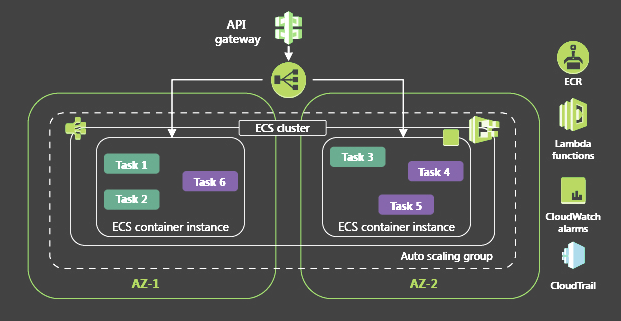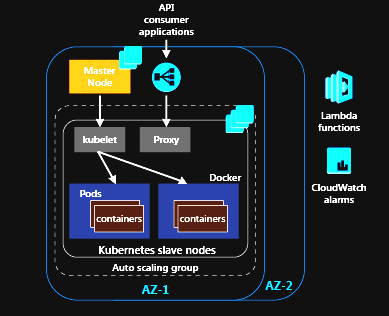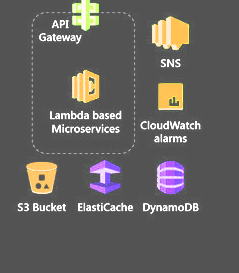Browse All Articles > Orchestrating microservices on AWS for solution design – What’s next?
Microservice architecture adoption brings many advantages, but can add intricacy. Selecting the right orchestration tool is most important for business specific needs.
There is undoubtedly Microservice design that helps in productive scaling and resource utilization. It too adjust the services with business domains. In any case, if done manually, conveying and following Microservices on a cluster host and checking asset usage gets progressively troublesome. Now, this is where the need of orchestrater arises. So, Akka.io., Spring cloud & Service fabric are certain frameworks & Docker with Swarm mode & Mesosphere's DCOS are options open to naturally underpin the Microservices execution.
Howbeit, let's investigate approaches around AWS Elastic Compute Cloud (EC2) - Container Service (ECS), Lambda as well as Kubernetes functions for sending and orchestrating Microservices over Amazon Web Services.
Key contemplations for solution design incorporate auto scaling, services scheduling & monitoring, service discovery & cluster management.
Dockerized Microservices on Amazon ECS: Over multiple accessibility zones & within a region ECS encourages running containers. The undertaking definitions help in indicating Docker container images to keep running over the clusters. Therefore, this solution gives backing to pull/push Docker & store images utilizing SaaS based AWS ECR. The outline underneath delineates ECS use in orchestrating Microservices hosted in Docker containers:
![API-gateway.png]()
Key advantages:
Orchestrator tool - Kubernetes for EC2 cluster Dockerized Microservices: An open source container, "Kubernetes" is an orchestrating tool. The pictorial representation underneath shows the way Kubernetes can be sent over AWS while overseeing containers in the Amazon Elastic Compute Cloud clusters. Kubernetes master node is in charge of checking as well as scheduling of the slave nodes. Where the pods are hosted these nodes actively monitors and schedules the slave nodes. "Pods" helps in determining the Docker container images to keep running over the clusters.
![API-2.png]()
Key advantages:
The custom execution is required utilizing lambada function & CloudWatch metrics to achieve the EC2 cluster autoscaling (means its registration and de-registration in the Kubernetes cluster).
Coordinated with AWS API Gateway Microservices are executed as AWS Lambda: Microservices that are container based helps in better resource usage. Despite on occasion many servers are required to arrange all the Microservices productively. In such a situation, where functionality is light-weight, AWS Lambda acts the liberation. Additionally, AWS Lambda functions permits to construct serverless backends. The outline here delineates Lambda functions as Amazon API Gateway in addition to the compute option for offering an HTTP endpoint. It too cache information/data in DynamoDB and S3 bucket along with the ElastiCache.
![API-3.png]()
Key advantages:
Howbeit, let's investigate approaches around AWS Elastic Compute Cloud (EC2) - Container Service (ECS), Lambda as well as Kubernetes functions for sending and orchestrating Microservices over Amazon Web Services.
Key contemplations for solution design incorporate auto scaling, services scheduling & monitoring, service discovery & cluster management.
Dockerized Microservices on Amazon ECS: Over multiple accessibility zones & within a region ECS encourages running containers. The undertaking definitions help in indicating Docker container images to keep running over the clusters. Therefore, this solution gives backing to pull/push Docker & store images utilizing SaaS based AWS ECR. The outline underneath delineates ECS use in orchestrating Microservices hosted in Docker containers:

Key advantages:
- Offloads the containerized Microservices orchestration & cluster management.
- Through CloudWatch automates the cluster and services monitoring.
- In ECS, Auto scales AWS EC2
- Auto scales errands in ECS service.
- Seller lock-in
- Custom execution required for programmed service discovery utilizing CloudWatch, CloudTrail as well as Lambda function.
- Right now only in few regions auto scaling at task level is accessible. A custom solution should be created utilizing AWS Lambda, CloudWatch and SNS for other regions.
Orchestrator tool - Kubernetes for EC2 cluster Dockerized Microservices: An open source container, "Kubernetes" is an orchestrating tool. The pictorial representation underneath shows the way Kubernetes can be sent over AWS while overseeing containers in the Amazon Elastic Compute Cloud clusters. Kubernetes master node is in charge of checking as well as scheduling of the slave nodes. Where the pods are hosted these nodes actively monitors and schedules the slave nodes. "Pods" helps in determining the Docker container images to keep running over the clusters.

Key advantages:
- No seller lock-in, Same solution can be sent on premise and cloud.
- Offloads intricate containerized Microservices orchestration
- Automates Kubernetes 'Pods' sets (service discovery) via "kube-dns" package.
- Screens as well as auto scales the Kubernetes set of containers (pods).
The custom execution is required utilizing lambada function & CloudWatch metrics to achieve the EC2 cluster autoscaling (means its registration and de-registration in the Kubernetes cluster).
Coordinated with AWS API Gateway Microservices are executed as AWS Lambda: Microservices that are container based helps in better resource usage. Despite on occasion many servers are required to arrange all the Microservices productively. In such a situation, where functionality is light-weight, AWS Lambda acts the liberation. Additionally, AWS Lambda functions permits to construct serverless backends. The outline here delineates Lambda functions as Amazon API Gateway in addition to the compute option for offering an HTTP endpoint. It too cache information/data in DynamoDB and S3 bucket along with the ElastiCache.

Key advantages:
- It is easy to construct & deploy
- Just need to pay for the resources utilized as a part of the execution, not for any consistently running servers.
- Through API Gateway integration automates the service discovery
- Scales naturally takes into account the incoming requests.
- High accessibility for both the Lambda functions and services.
- Screens Lambda functions automatically
- Merchant lock-in.
- Constrained debugging and troubleshooting support.
- All calls must finish execution within the time frame of 300 seconds.
- For other limitations refer
Have a question about something in this article? You can receive help directly from the article author. Sign up for a free trial to get started.


Comments (0)